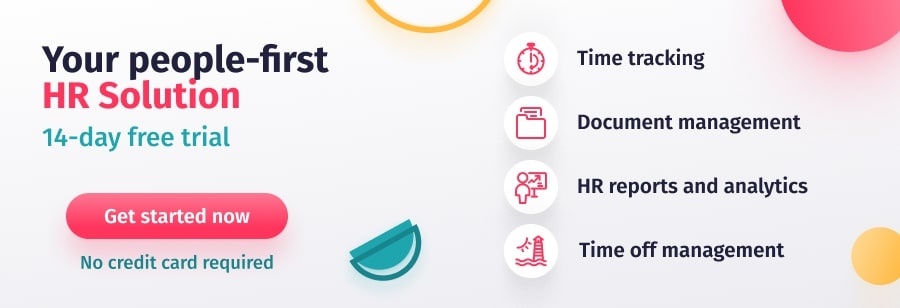Your greatest asset is your people, and their value is determined by the time and energy you invest in them. The more you nurture your employees with strong talent development strategies, the more you will gain as an organization. Benefits include increased employee engagement and retention rates, innovation and creativity, and gaining a competitive edge. In fact, the advantages are so great that, according to Statista Research Department, the global corporate learning industry is projected to reach a value of over 37 billion U.S. dollars by 2026.
In this guide, we will define talent development and take a look at the benefits of creating a talent development program in your organization. We will also share a few tips and strategies to help you implement, measure, and develop talent in the workplace.

What is Talent Development?
So, what does talent development mean?
Talent development, also known as HR talent development, is a strategy used to teach employees new skills and abilities. This usually includes upskilling and reskilling, as well as preparing employees for promotions and career advancement. Talent development can also be a useful tool for uncovering hidden talent. Development can take the form of training, L&D, mentorship, or coaching. Ultimately, the aim is to develop, motivate, and retain top talent.
Aside from boosting professional development on an individual level, talent development also benefits employers. This is because the right talent development strategy can align employees with business goals and objectives. This, in turn, helps organizations stay competitive in a continuously evolving global market.
Developing Talent Within a Company: What is a Talent Development Program?
A talent development program is a series of processes used to identify and nurture the potential of employees. Put simply, it is a training and development tool that prepares employees for future roles in the business. The aim of the program is to identify skill gaps, offer learning and training opportunities, and encourage employees to grow in line with organizational goals. This might be through training, coaching, mentorship, or shadowing.
The main objectives of a talent development program are:
- Adapting to evolving business environments, such as the changes experienced during the Covid-19 pandemic and the introduction of new ways of working.
- Creating a high-performance workforce that helps your organization reach its objectives.
- Reducing skills gap in line with your business needs.
- Reskilling employees so that your organization can stay relevant in a competitive market
- Discovering and nurturing hidden talent.
- Retaining and motivating your top talent, as well as attracting new talent to your company.
- Increasing employee engagement, motivation, performance, and productivity levels.
The Importance of Talent Development
Why is talent development important?
Here are just a few of the benefits of developing talent in the workplace:
- Talent development engages and motivates employees. Without a clear talent development plan, it’s difficult for your employees to see a clear purpose in their work. In contrast, offering recognition and opportunities for progression can be the ultimate motivator. This increases productivity and performance.
- Helps you retain talent. People need the chance to progress, and they need to see your strategy for helping them do it. Your employees are far more likely to stay at your company if you take an active role in their learning and development.
- Professional talent development can be a great tool for closing your skill gaps. You can identify which skills you’re lacking, and which learning pathways will help your employees get where they need to be.
- Investing in corporate talent development doesn’t just benefit your employees; it also drives better customer experiences. Aside from ensuring they have the right skills, if your employees are motivated and engaged, it will be reflected in their interactions with your customer base.
- Focusing on building organizational talent is also a great way to create a learning culture that aligns all your employees with the vision, mission, and values of your organization. This will help you stand out from the crowd and attract top talent.
Talent Development Strategies
Before you can implement a program for talent development training, you need to design a talent development strategy that is aligned with the needs and goals of your organization.
You need to take into account a number of aspects when you design your talent development strategy. You need to consider your current and future needs, establish pathways for learning, and promote actions that help you nurture and sustain employee development initiatives.
What areas of development do you need to focus on? Which skills are lacking in your company? How should you be training your employees? And what about the evolving expectations of your workforce? How will you inspire your employees and promote a positive work environment that they can connect with?
One way to retain top talent and adapt to evolving employee expectations is to use a tool known as design thinking in HR. Design thinking aims to improve productivity by putting the employee experience first. It’s about designing a productive and meaningful employee experience through solutions that are compelling, enjoyable, and simple. In other words, put yourself in the shoes of your employees and rely on feedback and experiences in order to find the best strategy for talent development in your company.
How to Develop Talent in an Organization: 5 Key Steps
We are now going to take a look at the five stages involved in designing, implementing, and managing a development plan that sets you up for success.
Define your Organizational Goals
The first step in creating your talent development program is defining your organizational goals. Think about your overall business strategy here. What are your mid and long-term goals? Which skills does your workforce need in order to get where you want to be?
This stage will help you define a clear strategy that ensures you are investing in the right initiatives. Understanding where you want to be will also help you communicate a clear strategy so that you get every level of your company on board.
Identify Needs and Opportunities
The next stage in the talent development process involves conducting a training needs analysis to identify which areas of L&D you should be focusing on. This will help you understand which skills your organization is lacking, and which areas of development you need to invest in.
Use surveys and interviews to identify employee skills and interests. You can use Factorial’s Skills Matrix Template to track the development of skillsets and compare learned competencies with overall objectives. You can then align all the results with your talent development strategy.
Design your Talent Development Program
Once you’ve done all your research and defined your goals and strategy, it’s time to design your talent development plan for employees. This means deciding what you are going to teach, how you are going to teach it, and what tools and resources you will need.
Will training be practical or hands-on? Who will act as your instructors – your managers or external coaches? Will you use a learning management system to streamline development processes?
This is perhaps the most vital stage of the process, so make sure you take the time to consider all options and design employee training programs that work best with the particular needs of your business.
Promote Mentorship & Coaching in the Workplace
The best talent development programs go beyond formal training and take into account the needs and learning styles of all employees. Consider using a range of talent development methods such as on-the-job learning, workplace mentorship programs, coaching in the workplace, performance coaching, e-learning, self-learning, or peer mentoring.
Create a Culture of Continuous Learning
Offering the right training is great, but a better way to retain and develop top talent is by creating the right environment. This means creating a culture of continuous learning and growth in your company.
Motivate your employees to spend time every day on their professional development. Encourage them to learn and reflect on their work. Focus on creating a learning culture of learning that aligns all your employees with the vision, mission, and values of your organization. And, most importantly, make sure you have the right structures and systems in place to support learning and continuous growth.
How to Measure Talent Development
The final vital stage of any talent development program is making sure you implement processes so that you can monitor and measure the development of your workforce. This means setting clear goals and using key performance indicators to measure the progress of each individual. This will help you gain insights into existing gaps and weaknesses so that you can adjust your strategy accordingly.
For example, you could measure retention levels, turnover, absenteeism, high-potential talent rates, and training spending. You could also track indicators that measure employee and customer satisfaction levels, engagement, loyalty, and motivation levels. Make sure your metrics are clear and measurable so that you can track the impact of your development programs.
Another vital tool for monitoring and measuring the success of your talent development plan is checking in regularly with your employees. Conduct regular interviews to see how they are getting on with the program. Ask them for feedback, good and bad. What are they getting from the program? What would help them develop further? This will help you determine if you need to offer more training and development opportunities to your employees in order to get the most from your program.

